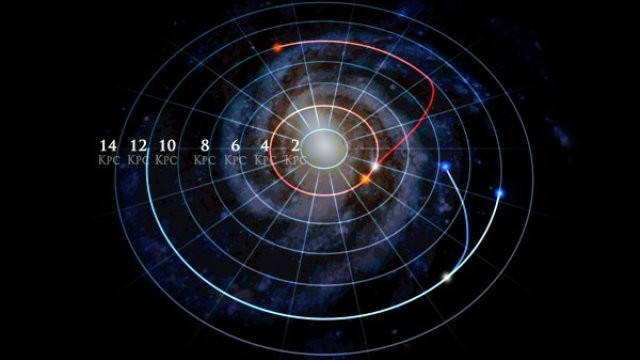Milky Way map shows many stars have moved out from place of birth

A third of the stars in the Milky Way have dramatically changed their orbits and moved away from their birthplaces, reveals a new map of the galaxy created by scientists with the Sloan Digital Sky Survey (SDSS).
"In our modern world, many people move far away from their birthplaces, sometimes halfway around the world," said Michael Hayden, graduate student at New Mexico State University and lead author of the new study. "Now we're finding the same is true of stars in our galaxy – about 30 percent of the stars in our galaxy have traveled a long way from where they were born."
Scientists used the SDSS Apache Point Observatory Galactic Evolution Explorer (APOGEE) spectrograph to observe 100,000 stars during a four-year period and create a new map of the Milky Way.
For the last six years, NMSU astronomers along with collaborators used the 2.5-metre SDSS telescope at the Sacramento Mountains to complete studies of Milky Way stars.
It was by measuring elements in the atmosphere of each star through spectral measurements that the team was able to create a map of the galaxy.
"From the chemical composition of a star, we can learn its ancestry and life history," said Hayden, who is completing his PhD at NMSU this summer.
The spectra, which are detailed measurements of the various wavelengths of light emitted by a star, help astronomers know the elements and compounds on the star.
"Stellar spectra show us that the chemical makeup of our galaxy is constantly changing," said Jon Holtzman, NMSU astronomy professor who was involved in the study. "Stars create heavier elements in their cores, and when the stars die, those heavier elements go back into the gas from which the next stars form."
Each generation of stars thus has a higher percentage of heavier elements than the previous one.
Regions of the galaxy vary in star formation rates with some parts having more generations of new stars with heavier elements. By tracing these elements astronomers can say where a star was born.
In the latest study by NMSU, 15 elements like carbon, silicon and iron were mapped in stars from various parts of the galaxy.
Up to 30% of stars had compositions indicating they were far away from home, having formed in parts of the galaxy away from current positions.
This migration could be explained by a model in which stars move radially, away or closer to the galactic centre with time.
These random motions are likely caused by irregularities in the galactic disk, as in the Milky Way's spiral arms.
The new study is the first clear evidence that migration, seen in some stars, occurs throughout the galaxy.
"These latest results take advantage of only a small fraction of the available APOGEE data," said Steven Majewski, the principal investigator of APOGEE. "Once we unlock the full information content of APOGEE, we will understand the chemistry and shape of our galaxy much more clearly."
The study was published on 29 July in The Astrophysical Journal.
© Copyright IBTimes 2025. All rights reserved.





















